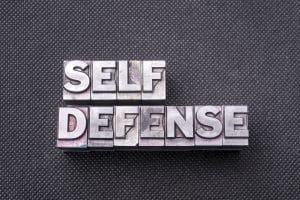When Is Self-Defense Justified in Texas?
 In order to lawfully use self-defense as a legal strategy, a defendant must prove his or her justification in taking assaultive actions based on either threats of violence or actual violence on the part of the other individual.
In order to lawfully use self-defense as a legal strategy, a defendant must prove his or her justification in taking assaultive actions based on either threats of violence or actual violence on the part of the other individual.
Under Texas law, a person is not guilty of assault if he or she committed actions for self-protection that are considered reasonable at the time and under the circumstances in which they were taken.
What is “reasonable” force?
In order to use self-defense legally against a charge of assault, the person must be shown to have used the minimum amount of force possible in order to deter or prevent an attack. The force used must be considered “reasonable” force. In short, if someone flips you “the bird” and you respond by using your fists, that is not a reasonable amount of force.
The force you used to assault someone in self-defense in order to protect yourself from the threat of violence or actual violence may not be more than the amount of force required to protect yourself. In addition, the individual you attack may not be a poor match for you in terms of size, gender, and age. If you do so, and the other individual is killed as a result, you may be charged with criminal homicide.
The state must prove criminal intent
In an assault case, the prosecutor has the burden of proof to demonstrate the event in question was an actual illegal assault and that the defendant is guilty beyond a reasonable doubt. In order to prove this, prosecutors must demonstrate criminal intent as the motive behind the assault. Criminal intent includes the intent of the defendant to threaten or harm the other person with anger or malice.
However, when the defendant claims self-defense, he or she carries the burden of proof. The defendant’s defense lawyer must prove the defendant was in immediate peril and sincerely believe that the only option was to use force to prevent serious injury. The defense attorney must also prove that only sufficient force was employed to stop such an injury from occurring.
Defending one or more other persons may also be self-defense
Another basis for using self-defense is defending others. In this case, the defendant must establish that he or she had reason to believe that another person or persons would be under threat of or subjected to harm by a third person, and that the defendant attacked the third person to defend the other person or persons.
Threat of violence can establish self-defense
As briefly mentioned above, the threat of violence without actual violence occurring is enough to establish self-defense in many cases. In order to act in self-defense in these cases, the defendant must have received at a minimum a threat of violence. Often, these cases involve the word of one person against the word of another person. This defense may be used to protect yourself and your property when assaulting a prowler, burglar, or arsonist in order to protect yourself, your family, or your property.
The Castle Doctrine and Stand Your Ground laws
The Castle Doctrine was enacted in 1995, and then modified in 2007 to “Stand Your Ground.” Under the law, an individual may employ reasonable force when defending their home, vehicle, or other property. This means that even if you are not threatened with bodily injury, but your home or vehicle is being unlawfully invaded, you have the right under the law to act in self-defense rather than retreat.
Our self-defense attorneys at Mary Beth Harrell Criminal Defense and DWI Lawyers understand the strategies used by prosecutors to persuade juries to convict defendants on assault charges. As a former prosecutor, Mary Beth Harrell is well-equipped to fight intelligently and tenaciously on your behalf against the assault charges you are facing. She will fight vigorously to clear your name and reputation. To schedule a consultation with our homicide attorneys call Mary Beth Harrell today at 254.680.4655 or complete our contact form. From our offices in Killeen and Copperas Cove, we are here to serve you.

I’ve dedicated my legal career to defending my clients. I demand all the evidence. I investigate all the facts, the so-called witnesses and even the police officers. I make it my business to know the law. Cases can be won or lost before you even set foot inside the courtroom.
Read more about Mary Beth Harrell
